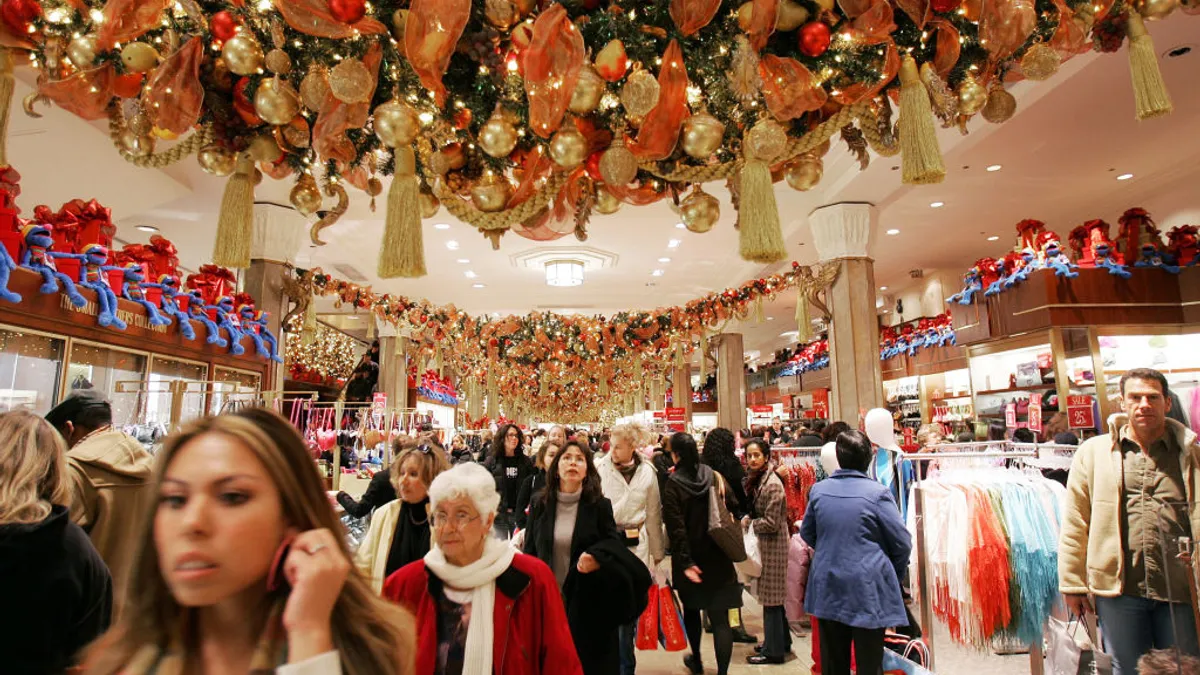Dive Brief:
- Retail sales rose 0.4% last month compared with September and 2.8% in the year since October 2023, the Commerce Department said Friday, signaling the possibility of solid consumer spending during the coming holiday season.
- Among the 13 retail categories, eight registered stronger sales, including autos, food service and drinking places, and electronics and appliance stores, the Commerce Department reported. Sales declined the most at furniture stores, miscellaneous retailers and health and personal care stores.
- “Growth in consumer spending has remained strong, supported by increases in disposable income and solid household balance sheets,” Federal Reserve Chair Jerome Powell said Thursday in a speech.
Dive Insight:
Recent signs of robust consumer spending, solid hiring and persistent inflation prompted traders in interest rate futures to reduce the odds that the Fed will cut the main interest rate by a quarter percentage point at its next meeting in December. They saw a 58% probability of such a reduction compared with 72% on Thursday.
Defying forecasts of recession, GDP grew at annual rates of 1.4% in Q1, 3% in Q2 and 2.8% in Q3, according to the Bureau of Economic Analysis. GDP will probably expand at a 2.5% annual rate during the fourth quarter, the Atlanta Fed said Friday.
“The economy is in a very good place now, and inflation is coming back down to target, the labor markets are healthy and we’re seeing solid growth,” Boston Fed President Susan Collins said Friday on Bloomberg Television, echoing comments by Powell on Thursday.
Referring to monetary policy, Collins also aligned with Powell, saying “we’re not on a present path, and so we’ll have to look carefully at the data and see what makes sense when we get to Dec. 18,” the last day of a two-day meeting of policymakers.
Chicago Fed President Austan Goolsbee said Friday the central bank has far to go in reducing interest rates so that currently restrictive monetary policy neither slows nor spurs economic growth.
“I still think we have a long way to go down with rates,” Goolsbee said in a Bloomberg Television interview. The central bank cut the federal funds rate by 0.5 percentage points in September and by 0.25 percentage points this month to a range between 4.5% to 4.75%.
When policymakers meet, “everything's always on the table,” Goolsbee said. “But there are no guarantees, and there shouldn't be.”
Fueling about 70% of economic growth, consumer spending has blown through predictions of a slump, propelled by solid wage gains and rising sentiments among U.S. households.
Consumer optimism in the strength of the economy six months in the future hit the highest level since July 2021, with expectations for personal finances rising 6%, according to a November survey by the University of Michigan.
Consumer sentiment increased 3.5% to the highest reading in six months, and expectations for short-run business conditions jumped 9%, according to Joanne Hsu, director of the university’s consumer survey.
Last month the mood among consumers improved more than any month since March 2021, the Conference Board said in a report on its Consumer Confidence Index.
All five components of the index improved, including consumers’ assessments of current business conditions, the availability of jobs, future business conditions, future income and the future availability of jobs, the Conference Board said.












